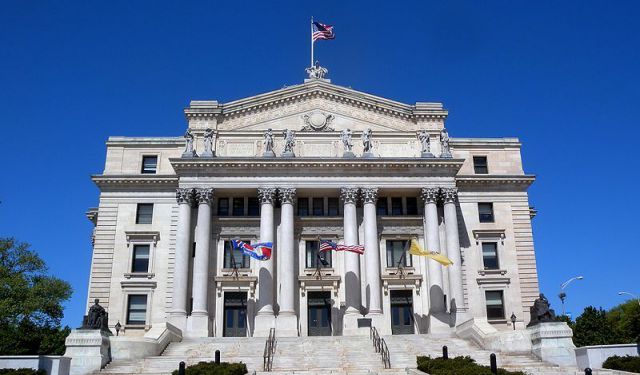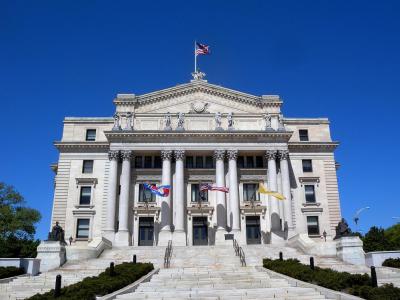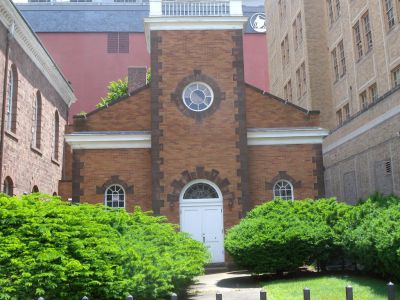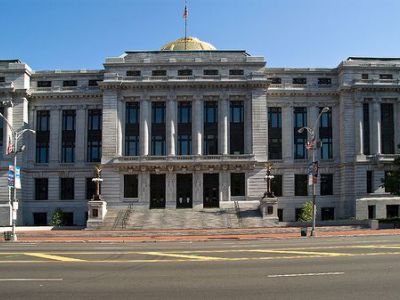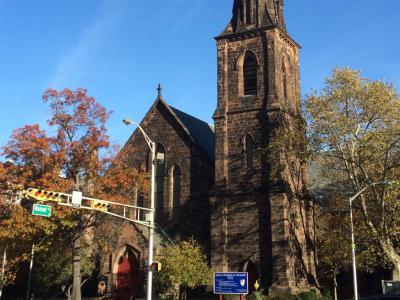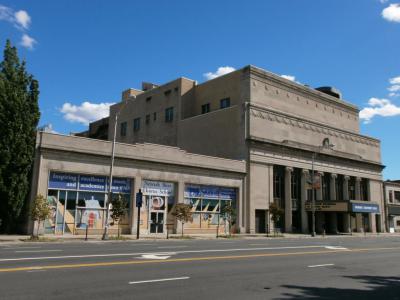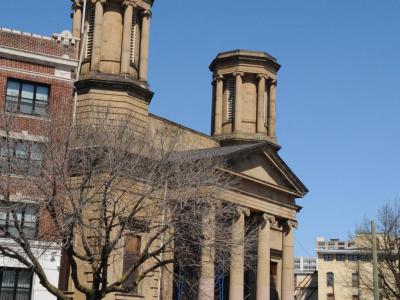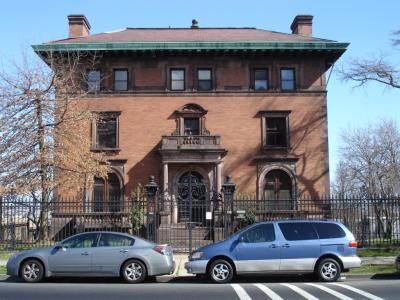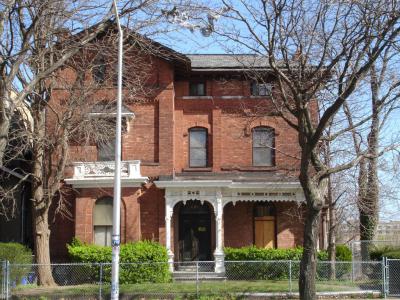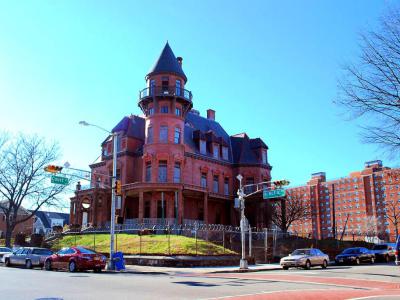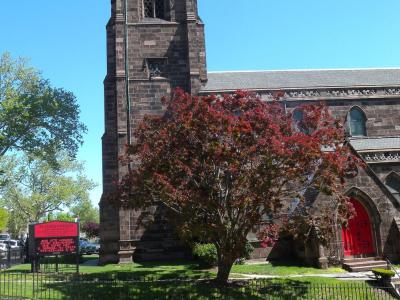Newark's Historical Buildings Walking Tour (Self Guided), Newark
Founded in 1666, Newark has no shortage of historic locations: districts, buildings, parks, cemeteries, and other venues. Much of its old-time architecture are notable sites listed on the National Register of Historic Places.
One such is the Essex County Courthouse, a striking example of Renaissance architecture, built in 1904. This grand building, with its impressive marble columns, ornate decorations, and a glass-domed roof, remains a functional legal space and a central historic landmark in the city.
The Old First Presbyterian Church is a testament to Newark's early religious history. Founded in 1667, the church has seen numerous renovations but retains its historical charm and significance. Meanwhile, Newark City Hall, constructed in 1902, symbolizes the city's governance and boasts beautiful Beaux-Arts design.
Nearby, Grace Church, an Episcopal sanctuary founded in the 1830s, features a stunning Gothic Revival style and is known for its historic organ and rich music tradition. Newark Symphony Hall, completed in 1925, is a cultural gem that hosts a variety of performances and events, continuing its legacy as a premier venue for the arts.
South Park Calvary United Presbyterian Church, a historic site with origins dating back to the mid-19th century, serves as a vibrant community venue. The Feigenspan Mansion, built in 1901, reflects the opulent lifestyle of early 20th-century industrialists and is a striking example of American Renaissance architecture.
The Glencoe Mansion, another architectural gem, is a High Victorian Italianate-style edifice, showcasing Newark's historical wealth with its ornate façade and luxurious interiors. The Krueger-Scott Mansion, a grand residence from the 1880s, is a late Victorian and Queen Anne-style landmark preserved through community efforts.
Finally, Saint James A M E Church, established in 1850, is known for its florid Gothic style and rich interior features.
To truly appreciate Newark's historical richness, take a walking tour of these landmarks. Each site tells a unique story and contributes to the city's cultural tapestry. Dive into Newark's history and explore these remarkable places to experience the legacy that continues to shape the city today.
One such is the Essex County Courthouse, a striking example of Renaissance architecture, built in 1904. This grand building, with its impressive marble columns, ornate decorations, and a glass-domed roof, remains a functional legal space and a central historic landmark in the city.
The Old First Presbyterian Church is a testament to Newark's early religious history. Founded in 1667, the church has seen numerous renovations but retains its historical charm and significance. Meanwhile, Newark City Hall, constructed in 1902, symbolizes the city's governance and boasts beautiful Beaux-Arts design.
Nearby, Grace Church, an Episcopal sanctuary founded in the 1830s, features a stunning Gothic Revival style and is known for its historic organ and rich music tradition. Newark Symphony Hall, completed in 1925, is a cultural gem that hosts a variety of performances and events, continuing its legacy as a premier venue for the arts.
South Park Calvary United Presbyterian Church, a historic site with origins dating back to the mid-19th century, serves as a vibrant community venue. The Feigenspan Mansion, built in 1901, reflects the opulent lifestyle of early 20th-century industrialists and is a striking example of American Renaissance architecture.
The Glencoe Mansion, another architectural gem, is a High Victorian Italianate-style edifice, showcasing Newark's historical wealth with its ornate façade and luxurious interiors. The Krueger-Scott Mansion, a grand residence from the 1880s, is a late Victorian and Queen Anne-style landmark preserved through community efforts.
Finally, Saint James A M E Church, established in 1850, is known for its florid Gothic style and rich interior features.
To truly appreciate Newark's historical richness, take a walking tour of these landmarks. Each site tells a unique story and contributes to the city's cultural tapestry. Dive into Newark's history and explore these remarkable places to experience the legacy that continues to shape the city today.
How it works: Download the app "GPSmyCity: Walks in 1K+ Cities" from Apple App Store or Google Play Store to your mobile phone or tablet. The app turns your mobile device into a personal tour guide and its built-in GPS navigation functions guide you from one tour stop to next. The app works offline, so no data plan is needed when traveling abroad.
Newark's Historical Buildings Walking Tour Map
Guide Name: Newark's Historical Buildings Walking Tour
Guide Location: USA » Newark (See other walking tours in Newark)
Guide Type: Self-guided Walking Tour (Sightseeing)
# of Attractions: 10
Tour Duration: 2 Hour(s)
Travel Distance: 2.8 Km or 1.7 Miles
Author: leticia
Sight(s) Featured in This Guide:
Guide Location: USA » Newark (See other walking tours in Newark)
Guide Type: Self-guided Walking Tour (Sightseeing)
# of Attractions: 10
Tour Duration: 2 Hour(s)
Travel Distance: 2.8 Km or 1.7 Miles
Author: leticia
Sight(s) Featured in This Guide:
- Essex County Courthouse
- Old First Presbyterian Church
- Newark City Hall
- Grace Church
- Newark Symphony Hall
- South Park Calvary United Presbyterian Church
- The Feigenspan Mansion
- Glencoe Mansion
- The Krueger-Scott Mansion
- St. James A.M.E. Church
1) Essex County Courthouse
The Essex County Courthouse stands as a monumental centerpiece in the heart of Newark. Constructed in 1906 by the Piccirilli Brothers with designs by renowned architect Cass Gilbert, the courthouse exemplifies the Renaissance architectural style. Its grandeur is highlighted by fine marble columns, ornate decorations, and a striking glass-domed roof, all contributing to its status as a historic and architectural landmark.
Upon approaching the main entrance, visitors are greeted by statues symbolizing "Truth" and "Power," flanking the entryway. These sculptures set the tone for the courthouse's solemn purpose, embodying the principles of justice and authority that the building represents. Additionally, nine allegorical statues grace the pediment above, each embodying various virtues and concepts central to the judicial system and civic life.
Inside, the courthouse's elegance continues with intricate details and craftsmanship evident throughout its halls and chambers. The use of fine marble and other luxurious materials reflects the significance of the courthouse as a center of justice and governance for Essex County. The glass-domed roof allows natural light to illuminate the interior, adding to the building's majestic atmosphere and providing a sense of openness and transparency.
The Essex County Courthouse not only serves as a functional space for legal proceedings but also stands as a testament to early 20th-century architectural excellence. Its design and construction have made it a notable landmark in Newark, attracting visitors and history enthusiasts alike.
Upon approaching the main entrance, visitors are greeted by statues symbolizing "Truth" and "Power," flanking the entryway. These sculptures set the tone for the courthouse's solemn purpose, embodying the principles of justice and authority that the building represents. Additionally, nine allegorical statues grace the pediment above, each embodying various virtues and concepts central to the judicial system and civic life.
Inside, the courthouse's elegance continues with intricate details and craftsmanship evident throughout its halls and chambers. The use of fine marble and other luxurious materials reflects the significance of the courthouse as a center of justice and governance for Essex County. The glass-domed roof allows natural light to illuminate the interior, adding to the building's majestic atmosphere and providing a sense of openness and transparency.
The Essex County Courthouse not only serves as a functional space for legal proceedings but also stands as a testament to early 20th-century architectural excellence. Its design and construction have made it a notable landmark in Newark, attracting visitors and history enthusiasts alike.
2) Old First Presbyterian Church
The Old First Presbyterian Church, situated in the Four Corners Historic District of Newark, New Jersey, is a beacon of historical and architectural significance. Known also as the First Presbyterian Church and Cemetery, this site has been central to the community since its inception. Established around 1668, initially as a Congregational Church, it transitioned to the Presbyterian denomination in 1720, reflecting its evolving community and spiritual needs.
The church’s current building, constructed in 1787 on Broad Street, showcases Colonial and Georgian architectural styles, making it a visually striking landmark. This building was erected on the site of an earlier meeting house voted for in 1668, underscoring the church's longstanding presence and significance in Newark.
Significant in its history is the church's role in absorbing other congregations; in 1945, it merged with the High Street-Sixth Presbyterian Church and later, in 1951, with the Olivet Presbyterian Church. The church was renamed the Old First Presbyterian Church in 1959, a nod to its deep historical roots and continuing legacy in the community.
Listed on the National Register of Historic Places in 1972, the Old First Presbyterian Church not only serves its congregation but also houses an old burial ground. This cemetery is the resting place of notable historical figures, such as William Burnet, Silas Condit, Thomas Ward, and Thomas M. Woodruff, linking it directly to significant moments and personalities in American history.
Today, Old First Church remains a vital part of Newark, committed to serving its community while preserving the rich history encapsulated within its walls and grounds. Its designation as a nationally registered historical landmark further celebrates its contribution to Newark’s cultural and historical tapestry.
The church’s current building, constructed in 1787 on Broad Street, showcases Colonial and Georgian architectural styles, making it a visually striking landmark. This building was erected on the site of an earlier meeting house voted for in 1668, underscoring the church's longstanding presence and significance in Newark.
Significant in its history is the church's role in absorbing other congregations; in 1945, it merged with the High Street-Sixth Presbyterian Church and later, in 1951, with the Olivet Presbyterian Church. The church was renamed the Old First Presbyterian Church in 1959, a nod to its deep historical roots and continuing legacy in the community.
Listed on the National Register of Historic Places in 1972, the Old First Presbyterian Church not only serves its congregation but also houses an old burial ground. This cemetery is the resting place of notable historical figures, such as William Burnet, Silas Condit, Thomas Ward, and Thomas M. Woodruff, linking it directly to significant moments and personalities in American history.
Today, Old First Church remains a vital part of Newark, committed to serving its community while preserving the rich history encapsulated within its walls and grounds. Its designation as a nationally registered historical landmark further celebrates its contribution to Newark’s cultural and historical tapestry.
3) Newark City Hall
Newark City Hall, situated prominently at Government Center, is a stunning example of Beaux Arts architecture dating back to its completion in 1902. This historic landmark was added to the National Register of Historic Places in 1978, solidifying its significance in American architectural history. Designed at a cost of $2.6 million, the building boasts a distinctive golden dome that catches the eye from afar.
The exterior of Newark City Hall is just the beginning of its grandeur. Inside, visitors are greeted by intricately carved marble, a majestic central staircase, and stained-glass skylights that illuminate the ornate interiors. The building's interior features also include decorative plasterwork and wrought-iron detailing, adding to its opulence and historical charm.
In 1986, local developer Harry Grant contributed to the building's allure by funding the gilding of its dome with 24-carat gold, enhancing its splendor and ensuring it remains a beacon in Newark's skyline. Recognizing its importance, Newark City Hall underwent a significant renovation in 2006, a project costing $18 million aimed at preserving its architectural integrity while modernizing its facilities to meet contemporary needs. Today, Newark City Hall continues to serve as the administrative hub of the city, a testament to Newark's rich history and enduring civic pride.
The exterior of Newark City Hall is just the beginning of its grandeur. Inside, visitors are greeted by intricately carved marble, a majestic central staircase, and stained-glass skylights that illuminate the ornate interiors. The building's interior features also include decorative plasterwork and wrought-iron detailing, adding to its opulence and historical charm.
In 1986, local developer Harry Grant contributed to the building's allure by funding the gilding of its dome with 24-carat gold, enhancing its splendor and ensuring it remains a beacon in Newark's skyline. Recognizing its importance, Newark City Hall underwent a significant renovation in 2006, a project costing $18 million aimed at preserving its architectural integrity while modernizing its facilities to meet contemporary needs. Today, Newark City Hall continues to serve as the administrative hub of the city, a testament to Newark's rich history and enduring civic pride.
4) Grace Church
Grace Church, founded 1837, stands as a distinguished example of Anglo-Catholic architectural style and Gothic Revival design. Designed by Richard Upjohn, renowned for his work on Trinity Church in New York City, the church building was consecrated on October 5, 1848. It occupies a historic site once home to the old Essex County Courthouse and Jail, which was destroyed by fire in 1835. Designated a National Historic Landmark in 1987, Grace Church is celebrated for its architectural grandeur and historical significance in Newark.
Visitors to Grace Church are welcomed into a tranquil atmosphere that embraces traditional 19th-century Anglo-Catholic liturgical practices. The church's liturgy is marked by openness and encourages active participation, allowing congregants to engage deeply in worship. Organ music, performed during liturgical ceremonies, enriches the spiritual experience, with the church's Casavant Frères tracker organ, installed in 1990, serving as a centerpiece for choir concerts and organ recitals.
The church's music tradition includes the historic legacy of Samuel A. Ward, who composed the tune "Materna," later adapted as "America the Beautiful," while serving as the parish organist in 1882.
Throughout its history, Grace Church has been a place of community engagement and cultural enrichment in Newark. The Grace Church Music Society, founded in 2008, continues to organize a vibrant series of recitals and concerts, furthering the church's commitment to fostering artistic expression and spiritual growth among its members and the broader community.
Visitors to Grace Church are welcomed into a tranquil atmosphere that embraces traditional 19th-century Anglo-Catholic liturgical practices. The church's liturgy is marked by openness and encourages active participation, allowing congregants to engage deeply in worship. Organ music, performed during liturgical ceremonies, enriches the spiritual experience, with the church's Casavant Frères tracker organ, installed in 1990, serving as a centerpiece for choir concerts and organ recitals.
The church's music tradition includes the historic legacy of Samuel A. Ward, who composed the tune "Materna," later adapted as "America the Beautiful," while serving as the parish organist in 1882.
Throughout its history, Grace Church has been a place of community engagement and cultural enrichment in Newark. The Grace Church Music Society, founded in 2008, continues to organize a vibrant series of recitals and concerts, furthering the church's commitment to fostering artistic expression and spiritual growth among its members and the broader community.
5) Newark Symphony Hall
Newark Symphony Hall was originally built in 1925 by the Shriners at a cost exceeding $2 million and was initially known as the Salaam Temple, or colloquially, The Mosque Theater. This four-story neo-classical building, designed by prominent Newark architect Frank Grad, was added to the National Register of Historic Places in 1977. Grad's design features Greek and Egyptian motifs, marble columns, a crystal chandelier, gold-leaf fretwork, and two-columned side promenades, contributing to its grandeur and historical significance.
For many years, Newark Symphony Hall was the home of the New Jersey Symphony Orchestra, the New Jersey State Opera, and the New Jersey Ballet Company. In 1964, the venue was renamed Newark Symphony Hall, reflecting its broader role as a cultural and community hub. The main concert hall, which seats 3,500, is named after Sarah Vaughan, a celebrated jazz singer and native of Newark, and is renowned for its excellent acoustics, making it a prime location for musical performances and concerts.
In addition to the main concert hall, Newark Symphony Hall houses other performance and event spaces. Newark Stage, a 200-seat black box theater, provides a versatile venue for theatrical productions, while the Terrace Ballroom is frequently used for receptions and other large gatherings. These spaces make Newark Symphony Hall a versatile and vital venue for the performing arts, capable of hosting a wide range of events from intimate performances to grand concerts.
For many years, Newark Symphony Hall was the home of the New Jersey Symphony Orchestra, the New Jersey State Opera, and the New Jersey Ballet Company. In 1964, the venue was renamed Newark Symphony Hall, reflecting its broader role as a cultural and community hub. The main concert hall, which seats 3,500, is named after Sarah Vaughan, a celebrated jazz singer and native of Newark, and is renowned for its excellent acoustics, making it a prime location for musical performances and concerts.
In addition to the main concert hall, Newark Symphony Hall houses other performance and event spaces. Newark Stage, a 200-seat black box theater, provides a versatile venue for theatrical productions, while the Terrace Ballroom is frequently used for receptions and other large gatherings. These spaces make Newark Symphony Hall a versatile and vital venue for the performing arts, capable of hosting a wide range of events from intimate performances to grand concerts.
6) South Park Calvary United Presbyterian Church
South Park Calvary United Presbyterian Church, built in 1853, is a historic landmark located in the Lincoln Park neighborhood of Newark. Despite being heavily damaged by a fire in 1992, which left only the facade standing, the church remains a significant architectural and historical site. Known also as the South Park Presbyterian Church, it was documented by the Historic American Buildings Survey in 1936 and added to the National Register of Historic Places on December 5, 1972, for its architectural significance.
The church was designed by John Welch, a prominent architect and one of the founders of the American Institute of Architects. His design employed the Greek Revival style, which is evident in the church's grand facade. The facade features a portico made of Nova Scotia brownstone, supported by four Ionic columns, and is flanked by twin circular colonnaded towers. This elegant and imposing structure has made the church an important architectural landmark in Newark.
Efforts have been made to preserve what remains of the South Park Calvary United Presbyterian Church. As of 2019, funding has been secured to stabilize the facade and repurpose the site as an outdoor performance space. This initiative aims to maintain the historical and cultural significance of the church while providing a functional and vibrant space for community events.
The transformation of the South Park Calvary United Presbyterian Church site into an outdoor performance area underscores the community's commitment to preserving its historical heritage.
The church was designed by John Welch, a prominent architect and one of the founders of the American Institute of Architects. His design employed the Greek Revival style, which is evident in the church's grand facade. The facade features a portico made of Nova Scotia brownstone, supported by four Ionic columns, and is flanked by twin circular colonnaded towers. This elegant and imposing structure has made the church an important architectural landmark in Newark.
Efforts have been made to preserve what remains of the South Park Calvary United Presbyterian Church. As of 2019, funding has been secured to stabilize the facade and repurpose the site as an outdoor performance space. This initiative aims to maintain the historical and cultural significance of the church while providing a functional and vibrant space for community events.
The transformation of the South Park Calvary United Presbyterian Church site into an outdoor performance area underscores the community's commitment to preserving its historical heritage.
7) The Feigenspan Mansion
The Feigenspan Mansion dates back to 1905 and was built for Christian Feigenspan, owner of one of the largest breweries in the United States. This fine four-story house, designed by architect Warrington G. Lawrence, is an exquisite example of the Second Renaissance Revival style and stands as one of the few buildings of its type. Today, the Feigenspan Mansion serves as the home of the Community Agencies Corporation.
Christian Feigenspan was a prominent figure in Newark's brewing industry, renowned for his "Pride of Newark" beer, which gained international acclaim by winning a silver medal at the 1891 Paris Exhibition. The mansion was notably designed to accommodate Feigenspan's wife, Marie, who used a wheelchair, making it one of the prime examples of accessible design in high-end residential living. The house includes a centrally-located elevator that provided access to the most important areas, and a bathroom shower stall designed to enable sitting. This thoughtful inclusion underscores the mansion's early adoption of universal (barrier-free) design principles.
The thirty-seven-room mansion features a three-story structure with three bays on the front facade and five bays on the side elevations. The exterior materials consist of Roman brick and sandstone trims used for the quoining, watertable, and moldings. The central bay on the front facade boasts an entrance arch framed by free-standing Tuscan columns, topped by a balustrated parapet around a baroque window with a broken pediment and side scrolls. The first-floor side windows also have balustrated balconies capped with cornice caps, while a glazed-in area at the back serves as a palm room.
Christian Feigenspan was a prominent figure in Newark's brewing industry, renowned for his "Pride of Newark" beer, which gained international acclaim by winning a silver medal at the 1891 Paris Exhibition. The mansion was notably designed to accommodate Feigenspan's wife, Marie, who used a wheelchair, making it one of the prime examples of accessible design in high-end residential living. The house includes a centrally-located elevator that provided access to the most important areas, and a bathroom shower stall designed to enable sitting. This thoughtful inclusion underscores the mansion's early adoption of universal (barrier-free) design principles.
The thirty-seven-room mansion features a three-story structure with three bays on the front facade and five bays on the side elevations. The exterior materials consist of Roman brick and sandstone trims used for the quoining, watertable, and moldings. The central bay on the front facade boasts an entrance arch framed by free-standing Tuscan columns, topped by a balustrated parapet around a baroque window with a broken pediment and side scrolls. The first-floor side windows also have balustrated balconies capped with cornice caps, while a glazed-in area at the back serves as a palm room.
8) Glencoe Mansion
The Glencoe Mansion, located on the easterly side of Martin Luther King Boulevard (formerly High Street), stands as a testament to the city's historical affluence and architectural grandeur. High Street was once one of Newark's most prominent addresses, lined with high-end residential buildings occupied by affluent families. The Glencoe Mansion, a three-story brick building designed in the High Victorian Italianate Style, epitomizes this bygone era of opulence and elegance.
The main façade of the mansion is a visual feast, with its three bays articulated beautifully with architectural elements. Horizontal brick belt coursing defines the floor divisions, separating tall windows and door openings, most of which are topped with segmental-arch lintels. The third floor, with its reduced height, accentuates the building's mass when viewed from below.
The symmetry of the façade is creatively disrupted by the northernmost bay, which projects forward and is capped by a gable roof. This bay features a variety of architectural details, from the first floor’s box bay to the bracket-supported hooded lintel on the second floor, culminating in paired round-arched windows on the third floor. The main entrance, part of a lavishly ornamented wooden open porch, adds to the façade's intricate design.
Inside, the Glencoe Mansion maintains the same level of decorative attention. The interiors boast plaster walls and ceilings adorned with crown moldings and medallions for lighting fixtures. Wood parquet floors and bronze hardware further enhance the mansion's luxurious appeal. Each room within the mansion reflects the high standards of craftsmanship and design characteristic of the High Victorian Italianate Style, making it a true architectural gem.
At the rear of the property, a Carriage House complements the main building. Constructed in 1871, the Carriage House adds another layer of historical significance to the estate. The entire property, including the mansion and the Carriage House, was added to the National Register of Historic Places on October 1, 1991, ensuring its preservation as a vital part of Newark's architectural heritage.
The main façade of the mansion is a visual feast, with its three bays articulated beautifully with architectural elements. Horizontal brick belt coursing defines the floor divisions, separating tall windows and door openings, most of which are topped with segmental-arch lintels. The third floor, with its reduced height, accentuates the building's mass when viewed from below.
The symmetry of the façade is creatively disrupted by the northernmost bay, which projects forward and is capped by a gable roof. This bay features a variety of architectural details, from the first floor’s box bay to the bracket-supported hooded lintel on the second floor, culminating in paired round-arched windows on the third floor. The main entrance, part of a lavishly ornamented wooden open porch, adds to the façade's intricate design.
Inside, the Glencoe Mansion maintains the same level of decorative attention. The interiors boast plaster walls and ceilings adorned with crown moldings and medallions for lighting fixtures. Wood parquet floors and bronze hardware further enhance the mansion's luxurious appeal. Each room within the mansion reflects the high standards of craftsmanship and design characteristic of the High Victorian Italianate Style, making it a true architectural gem.
At the rear of the property, a Carriage House complements the main building. Constructed in 1871, the Carriage House adds another layer of historical significance to the estate. The entire property, including the mansion and the Carriage House, was added to the National Register of Historic Places on October 1, 1991, ensuring its preservation as a vital part of Newark's architectural heritage.
9) The Krueger-Scott Mansion
The Krueger-Scott Mansion was constructed in 1888 and added to the National Register of Historic Places on November 9, 1972. This historic mansion was built by Gottfried Krueger, the founder of Newark's Gottfried Krueger Brewing Company, and cost $250,000 at the time of its construction. Krueger, a prominent figure in Newark's brewing industry, owned several other breweries as well. In 1926, the mansion was sold to the Valley of Newark Scottish Rite Freemasons for $100,000.
In 1958, Louise Scott purchased the mansion for $85,000. Scott, a pioneering African American beautician and businesswoman, operated a beauty school on the mansion's first floor while maintaining the upper levels as her private residence until her death in 1982. Following her passing, ownership of the mansion transferred to the city of Newark. Recognizing its historical significance, the New Jersey Historic Trust funded a bond for $625,812 in 1991 to stabilize the building's exterior.
Architecturally, the Krueger-Scott Mansion is a three-story brick building designed in the late Victorian style, with distinctive elements of the Queen Anne style. It features a five-story circular tower, a wrap-around porch, a steeply pitched roof, an asymmetrical facade, and an arched front entryway. The structure is a balloon frame with a brick facade, while the interior boasts lath and plaster walls, intricate wood molding, and hardwood flooring set into elaborate patterns.
The Krueger-Scott Mansion stands as a testament to Newark's rich historical and architectural heritage. Despite its varying uses and ownership over the years, the mansion remains a significant landmark, reflecting both the opulence of Newark's past and the community's ongoing efforts to preserve its historical treasures.
In 1958, Louise Scott purchased the mansion for $85,000. Scott, a pioneering African American beautician and businesswoman, operated a beauty school on the mansion's first floor while maintaining the upper levels as her private residence until her death in 1982. Following her passing, ownership of the mansion transferred to the city of Newark. Recognizing its historical significance, the New Jersey Historic Trust funded a bond for $625,812 in 1991 to stabilize the building's exterior.
Architecturally, the Krueger-Scott Mansion is a three-story brick building designed in the late Victorian style, with distinctive elements of the Queen Anne style. It features a five-story circular tower, a wrap-around porch, a steeply pitched roof, an asymmetrical facade, and an arched front entryway. The structure is a balloon frame with a brick facade, while the interior boasts lath and plaster walls, intricate wood molding, and hardwood flooring set into elaborate patterns.
The Krueger-Scott Mansion stands as a testament to Newark's rich historical and architectural heritage. Despite its varying uses and ownership over the years, the mansion remains a significant landmark, reflecting both the opulence of Newark's past and the community's ongoing efforts to preserve its historical treasures.
10) St. James A.M.E. Church
Saint James' A.M.E. Church is a historic landmark that dates back to its construction in 1850 by architect John Welch. Originally known as the High Street Presbyterian Church, it was dedicated in 1854. After a brief period of disbandment in 1926, the church was re-established and renamed as Bethel A.M.E. Church, later adopting its current name, Saint James' A.M.E. Church.
Architecturally, Saint James' A.M.E. Church is notable for its florid Gothic style, designed in the pointed style reminiscent of 14th-century architecture. Constructed from stone sourced from Little Falls, the church is one of John Welch's early projects upon arriving in the United States.
The interior of the church is spacious and cheerful, featuring unobtrusively rich stained glass windows that cast a soft mellow tone throughout the sanctuary. The inviting pews are cushioned in red, complementing the carpets, while the pulpit is crafted from elaborately carved oak. Gas lighting from side brackets and gilt candelabra with five burners each enhance the evening ambiance.
The church's construction reflects meticulous craftsmanship, with its hand-cut stone laid in a Flemish bond pattern. A prominent centrally located tower, styled in Norman architecture with early English elements, adds to the distinctive character of the facade.
Architecturally, Saint James' A.M.E. Church is notable for its florid Gothic style, designed in the pointed style reminiscent of 14th-century architecture. Constructed from stone sourced from Little Falls, the church is one of John Welch's early projects upon arriving in the United States.
The interior of the church is spacious and cheerful, featuring unobtrusively rich stained glass windows that cast a soft mellow tone throughout the sanctuary. The inviting pews are cushioned in red, complementing the carpets, while the pulpit is crafted from elaborately carved oak. Gas lighting from side brackets and gilt candelabra with five burners each enhance the evening ambiance.
The church's construction reflects meticulous craftsmanship, with its hand-cut stone laid in a Flemish bond pattern. A prominent centrally located tower, styled in Norman architecture with early English elements, adds to the distinctive character of the facade.
Walking Tours in Newark, New Jersey
Create Your Own Walk in Newark
Creating your own self-guided walk in Newark is easy and fun. Choose the city attractions that you want to see and a walk route map will be created just for you. You can even set your hotel as the start point of the walk.
Newark Introduction Walking Tour
Newark, the most populous city of New Jersey, is also one of the oldest cities in the United States, established in 1666. Settled by Puritans from New Haven Colony, Newark was initially a theocratic community, which diversified as new settlers introduced different ideas.
Named likely after Newark-on-Trent in England, the city's moniker reveals its colonial roots. Alternative theories... view more
Tour Duration: 2 Hour(s)
Travel Distance: 3.4 Km or 2.1 Miles
Named likely after Newark-on-Trent in England, the city's moniker reveals its colonial roots. Alternative theories... view more
Tour Duration: 2 Hour(s)
Travel Distance: 3.4 Km or 2.1 Miles
The Most Popular Cities
/ view all
